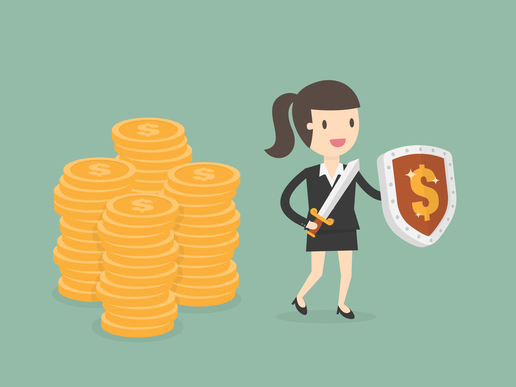The eBay chargeback system can leave a seller bewildered. There are lots of layers to it—eBay seller protection and buyer protection, PayPal chargeback policy, and credit card issuer policy all come into play in different situations.
This article was last updated and fact-checked on 4/5/2018.
This system can seem overwhelming. However, understanding it will help you avoid chargebacks. And since some chargebacks cost sellers 2.4 times the value of the transaction on average, the time you spend learning how to stop them will more than pay for itself.
What Are Chargebacks?

Chargebacks occur if somebody pays you through a debit or credit card, then goes to their card issuer (generally their bank) and demands the money back. You can expect to see the amount they paid deducted from your account along with a nasty fee.
When Can a Buyer Demand a Chargeback on an eBay Purchase?
Customers can initiate chargebacks if they believe the item they received didn’t match your description on eBay. They can also do it if they never received the item they bought, or if someone stole their card and used it to make a fraudulent transaction.
Of course, not everyone plays by the rules. Some “buyers” are really fraudsters who will buy an item from you and then file a chargeback after they get it.
I Only Accept PayPal. Does That Mean I’m Safe from Chargebacks?
Unfortunately, no. Just because somebody made a purchase through PayPal doesn’t mean they didn’t use a credit or debit card.
PayPal users can attach their cards to their account and use them to fund payments. If your customers use a card attached to their PayPal account to pay you, they can file a chargeback.
How Much Do They Cost?
Chargeback fees depend on how you processed the payment.
PayPal Chargeback Fee
You’ll need to pay the PayPal chargeback fee if the purchase doesn’t fall under PayPal Seller Protection. The fee is currently $20 for transactions in USD; see the full table here.
In good news, as long as PayPal processes the chargeback, you’ll only have to pay their fees. You won’t have to worry about paying a credit card issuer’s fees instead—or on top of theirs.
You can also expect additional expenses depending on the reason for the chargeback. You generally will lose all money spent on shipping and may be required to accept the return or allow the buyer to keep the item.
If your sale qualifies for Seller Protection and you prove you held up your end of the bargain, you won’t have to pay PayPal’s chargeback fee and you’ll get to keep the full payment. More on that later.
Card Issuer Chargeback Fees
If you set up an internet merchant account and a payment gateway account, you can accept credit cards directly rather than requiring customers to go through PayPal. This means you won’t have the benefit of PayPal Seller Protection. Unless you go through another service that offers similar protection, you’ll need to deal directly with the card issuers and their fees.
These fees depend on the issuer. Some may charge as “little” as $30, while others may charge as much as $100. A PayPal chargeback fee will almost always amount to less.
Who Decides Whether I Have to Pay a Chargeback?

Buyers can only use one type of purchase protection at a time. If they try to use more than one, the more powerful system wins. From most powerful to least powerful, these are:
- Card issuer chargeback
- PayPal Purchase Protection
- eBay Money Back Guarantee
So, if a buyer opens an eBay Money Back Guarantee claim and a PayPal Purchase Protection claim at the same time, eBay will close the claim on their end and only the PayPal claim will continue. If the buyer opens claims with all three, then both PayPal and eBay will close their claims and only the card issuer’s chargeback will proceed.
Likewise, if a chargeback is filed through the card issuer, they are the ones who will decide whether you must pay a chargeback—not PayPal or eBay.
eBay Chargebacks and PayPal
Since PayPal was originally owned by eBay, the two companies have a special relationship (although that will change in 2020). If the eBay Money Back Guarantee program decides that the buyer should get a refund, PayPal will automatically accept that decision.
The eBay Money Back Guarantee comes into play if the item never arrives or isn’t as described.
eBay Chargeback Protection
eBay chargeback protection doesn’t really exist. eBay may ban users for fraudulent chargebacks under the normal consequences for abusing eBay, but that’s scant comfort if the con artist has made off with $400 of your inventory and left you paying the fees.
While they can’t protect your wallet, they will at least protect your account. Read our quick guide to eBay seller protection to learn how they will shield your Feedback score and save you from unjustly having to provide a refund.
Luckily, PayPal chargeback policy will sometimes save the day.
PayPal Chargeback Protection

If a card issuer decides to put through a chargeback and PayPal Seller Protection doesn’t apply, you’re out of luck. PayPal will take the money out of your account along with that $20 chargeback fee.
However, if you are covered by Seller Protection, PayPal may cover most or all of your losses. As long as you meet the requirements for the type of dispute (Item Not Received or Unauthorized Transaction) and have documentation that the item was shipped to the correct address in a timely manner, you won’t need to refund the buyer or pay a chargeback fee.
The awesome thing about PayPal chargeback protection is that it can apply even if the card issuer decides in favor of the buyer. PayPal covers the refunds and fees and you get to keep your money.
eBay sellers should note that this protection doesn’t apply to claims that the item doesn’t match the description, or sales where you make the delivery yourself.
What Happens under PayPal Chargeback Policy If I Lose a Claim?
In that case, you must pay the chargeback fee and refund the cost of the item and shipping. PayPal will not refund any fees you paid in the process.
If you accidentally sent the wrong item, it should be returned to you. In many cases, though, the customer will be able to keep it.
How Do I Fight eBay Chargeback Claims?

Since eBay itself doesn’t deal with chargebacks, let’s focus on what you need to do to fight chargebacks either through PayPal or directly from the credit card issuer. Just be sure you understand the eBay Money Back Guarantee so you know when you’ll need to accept returns or provide refunds under eBay policy.
Fighting PayPal Chargebacks
PayPal quite clearly lays out the evidence you need to fight a chargeback that’s covered by Seller Protection. In short, you need:
- Proof that you shipped the item. This needs to include the address shown for the buyer on the PayPal transaction and the date the item was shipped.
- Delivery confirmation from the shipping company and the date the item was delivered.
- Signature confirmation for expensive items ($750+).
Those details should be enough to settle most chargebacks with PayPal. However, some chargebacks—such as those based on claims the item was not as described—will require you to settle things with the card issuer or bank. The same goes if you accept credit cards directly, of course.
Fighting Credit or Debit Card Chargebacks
To prepare for card issuer chargebacks, you may wish to gather additional evidence before shipping an item. Consider the following ways to build a bulletproof case:
- Get signature confirmation, even on less expensive items.
- Take photos of the item prior to shipping to demonstrate that it matches the description—and date them.
- Keep records of any conversations with the buyer. If they say one thing to you in a message on eBay and something else to the card issuer, you might be able to use that as evidence against their case.
Be warned that many card issuers care more about keeping their customers (the buyers) happy than doing what is right. Sometimes, even when you have rock-solid proof that you delivered exactly what the buyer ordered precisely on time, the banks will take your money anyway.
How Do I Avoid eBay Chargebacks?

The best form of eBay chargeback protection is avoiding situations where you’ll end up with chargebacks in the first place.
There are three ways to do this:
- Respond quickly to eBay messages. Chargebacks often occur because the seller took too long to answer and the buyer panicked.
- Provide exceptional customer service. Rather than sticking with the basic eBay returns policy, create a good ecommerce return policy that goes the extra mile and puts customer satisfaction first. Refunds and returns cost less than chargebacks, and being liberal with them can actually save you money.
- Block buyers who are likely to be scam artists. For example, you can block people with low Feedback scores, or who have violated eBay policies (which should block anyone who’s initiated a chargeback while they already had an eBay Money Back Guarantee claim open).
Providing the best customer service possible won’t just help you with chargebacks—it will also boost your eBay SEO and Feedback score. Consider integrating eBay with a helpdesk so you can take your support to the next level.
Summary
Every eBay chargeback you deal with will damage your business. Handle eBay customer service professionally to cut down on chargebacks, carefully document your deliveries so you can fight them when they occur, and take advantage of PayPal chargeback protection whenever possible.
Finally, remember that you will always face chargebacks and lose them occasionally. Keep reserve cash on hand so they’ll never put you out of business.





